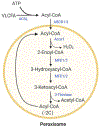Peroxisomes as cellular adaptors to metabolic and environmental stress
- PMID: 33674166
- PMCID: PMC8566112
- DOI: 10.1016/j.tcb.2021.02.005
Peroxisomes as cellular adaptors to metabolic and environmental stress
Abstract
Peroxisomes are involved in multiple metabolic processes, including fatty acid oxidation, ether lipid synthesis, and reactive oxygen species (ROS) metabolism. Recent studies suggest that peroxisomes are critical mediators of cellular responses to various forms of stress, including oxidative stress, hypoxia, starvation, cold exposure, and noise. As dynamic organelles, peroxisomes can modulate their proliferation, morphology, and movement within cells, and engage in crosstalk with other organelles in response to external cues. Although peroxisome-derived hydrogen peroxide has a key role in cellular signaling related to stress, emerging studies suggest that other products of peroxisomal metabolism, such as acetyl-CoA and ether lipids, are also important for metabolic adaptation to stress. Here, we review molecular mechanisms through which peroxisomes regulate metabolic and environmental stress.
Keywords: ether lipid; lipid metabolism; peroxisome; plasmalogen; reactive oxygen species; stress.
Copyright © 2021 Elsevier Ltd. All rights reserved.
Conflict of interest statement
Declaration of interests The authors declare no competing interests.
Figures






References
-
- Huybrechts SJ et al. (2009) Peroxisome dynamics in cultured mammalian cells. Traffic 10 (11), 1722–33. - PubMed
-
- Chu BB et al. (2015) Cholesterol transport through lysosome-peroxisome membrane contacts. Cell 161 (2), 291–306. - PubMed
-
- Chrousos GP (2009) Stress and disorders of the stress system. Nat Rev Endocrinol 5 (7), 374–81. - PubMed
Publication types
MeSH terms
Substances
Grants and funding
LinkOut - more resources
Full Text Sources
Other Literature Sources
Research Materials

